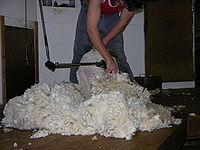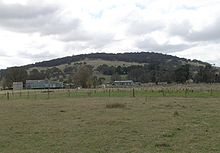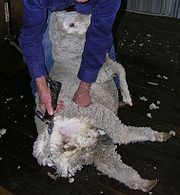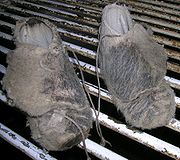
Sheep shearer
Encyclopedia


Domestic sheep
Sheep are quadrupedal, ruminant mammals typically kept as livestock. Like all ruminants, sheep are members of the order Artiodactyla, the even-toed ungulates. Although the name "sheep" applies to many species in the genus Ovis, in everyday usage it almost always refers to Ovis aries...
during crutching
Crutching
Crutching refers to the removal of wool from around the tail and between the rear legs of a sheep. It can also refer to removing wool from the heads of sheep or from the bellies of male sheep .-Motivation:...
or shearing
Sheep shearing
Sheep shearing, shearing or clipping is the process by which the woollen fleece of a sheep is cut off. The person who removes the sheep's wool is called a shearer. Typically each adult sheep is shorn once each year...
.
History
During the early years of sheep breeding in AustraliaAustralia
Australia , officially the Commonwealth of Australia, is a country in the Southern Hemisphere comprising the mainland of the Australian continent, the island of Tasmania, and numerous smaller islands in the Indian and Pacific Oceans. It is the world's sixth-largest country by total area...
, shearing was carried out by shepherd
Shepherd
A shepherd is a person who tends, feeds or guards flocks of sheep.- Origins :Shepherding is one of the oldest occupations, beginning some 6,000 years ago in Asia Minor. Sheep were kept for their milk, meat and especially their wool...
s, assigned servants, Ticket of Leave men, and free labourers using blade shears. As the sheep industry expanded, more shearers were required. Although the demand had increased, the conditions had not, and shearers had to contend with terrible working conditions, very long hours and low pay. In 1888, Australia became the first country in the world have a complete shearing, at Dunlop Station, finished using machines.
By 1915, most large Australian sheep station
Sheep station
A sheep station is a large property in Australia or New Zealand whose main activity is the raising of sheep for their wool and meat. In Australia, sheep stations are usually in the south-east or south-west of the country. In New Zealand the Merinos are usually in the high country of the South...
shearing shed
Shearing shed
Shearing sheds are large sheds located on sheep stations to accommodate large scale sheep shearing activities.In countries where large numbers of sheep are kept for wool, sometimes many thousands in a flock, shearing sheds are vital to house the necessary shearing equipment, and to ensure that the...
s had machines that were powered by steam engines. Later, internal combustion engines powered machines until rural power supplies became available.
Sheep shearing today
In most countries with large sheep flocks, the shearer is one of a contractor's team that go from property to property shearing sheep and preparing the wool for market. A workday starts at 7:30 am and the day is divided into four “runs” of two hours each. “Smoko” breaks of a half hour each are at 9:30 am and again at 3 pm. The lunch break is taken at 12 midday for one hour. Most shearers are paid on a piece rate, i.e., per sheep. The shearer collects a sheep from a catching pen, positions it on his “stand” on the shearing board and operates the shearing hand-piece. A shearer begins by removing the wool over the sheep's belly, which is separated from the main fleece by a rouseaboutRoustabout
A roustabout is a labourer typically performing temporary, unskilled work. The term has traditionally been used to refer to traveling-circus workers, natural gas, or oil rig workers....
while the sheep is still being shorn. The remainder of the fleece is taken off in one piece by following an efficient set of movements.
In the case of powered shears, the movements used are those devised by Godfrey Bowen, in approximately 1950, or the Tally-Hi method. In 1963, the Tally-Hi shearing system was developed by Kevin Sarre and the Australian Wool Corporation who promoted the technique using synchronised shearing demonstrations. Sheep struggle less using the Tally-Hi method, reducing strain on the shearer and there is a saving of about 30 seconds shearing each sheep. When finished, the shorn sheep is removed from the board via a chute in the floor, or wall, to a counting out pen, efficiently removing it from the shed.
The latest shearing patterns which are used by some of the most efficient shearers around the world, world record holders, world champions, etc. have less blows due to better sheep control and positioning. These patterns ensure that there is less strain placed on the sheep and the shearers due to the advanced techniques used.

In 1983 the Australian shearing industry was torn apart by the wide comb dispute and the ensuing 10 week strike that followed. The offending combs had been introduced by New Zealanders who were weaker union supporters. In 1984, Australia became the last country in the world to permit the use of wide combs, due to previous Australian Workers Union rulings.
The Shear Outback, Australian Shearers' Hall of Fame and museum, was officially opened on 26 January 2001 at Hay, New South Wales
Hay, New South Wales
Hay is a town in the western Riverina region of south western New South Wales , Australia. It is the administrative centre of Hay Shire Local Government Area and the centre of a prosperous and productive agricultural district on the wide Hay Plains....
in recognition the great wool industry and the great shearers of Australia, especially those of the Outback
Outback
The Outback is the vast, remote, arid area of Australia, term colloquially can refer to any lands outside the main urban areas. The term "the outback" is generally used to refer to locations that are comparatively more remote than those areas named "the bush".-Overview:The outback is home to a...
. The inaugural inductees into the Australian Shearers’ Hall of Fame are Jackie Howe (1861–1920), Julian Stuart
Julian Stuart
Julian Stuart was an Australian journalist, trade unionist, poet and politician.-Early career:John Alexander Salmon Stuart was born in Raymond Terrace, New South Wales and grew up on the Clarence River...
(1866–1929), Henry Salter MBE (1907–1997), Kevin Sarre (1933–1995) and John Hutchinson OAM. These inductees were chosen because they had won world championships or had shorn high tallies.
Clothing

- Shearers' jeans or dungarees which have a double thickness of material over the front and lower back leg.
- Shearers' singlets: singlets with patches under the arms where the sheep’s feet are placed during shearing.
- Shearers' boots: leather boots with elastic sides or lacing across the front and a flap to prevent the comb catching in the laces
or
- Shearers' moccasins: a modern synthetic fleece version of the laced boots above, which have a non-slip coating on the sole to prevent slipping on grease in the shearing sheds. These moccasins are washable to prevent the spread of disease and lice etc.
Records
On 10 October 1892, Jackie Howe set a record of 321 sheep shorn in 7 hours and 40 minutes, using blade shears. He had previously set a weekly aggregate record of 1,437 sheep over a total working week of 44 hours and 30 minutes.While Howe's weekly aggregate record remained until at least 2005, his daily record tally was broken using machine shears by Ted Reick in 1950.
Kevin Sarre was one of the world’s greatest 20th Century machine shearers. He won many shearing championships including five Australian Titles, was a Golden Shears Winner in 1963 and held World Shearing Record in 1965 of shearing 346 Merinos. In 1963, Kevin in assosciation with the Australian Wool Board, was instrumental in the development of the revolutionary Tally-Hi shearing technique, and went on to supervise the training of this technique throughout Australia. The Tally-Hi shearing technique reduced the time taken to shear a sheep by approximately 30 seconds. Kevin’s daughter daughter Deanne holds the Australian women’s shearing record, having shorn 392 sheep in a day.
Henry Salter (1907–1997) MBE won the first organised shearing contest at Pyramid Hill
Pyramid Hill, Victoria
Pyramid Hill is a town in Victoria, Australia located in the Shire of Loddon. It is located north of Melbourne and north of Bendigo. At the 2006 census, Pyramid Hill had a population of 465. The town has its own railway station....
in 1934 and in 1953 was a machine shearing champion. He continued to use blade shears until he was well into his 80s. In 1946 Salter organised the first Australian shearing school at Kerang, Victoria
Kerang, Victoria
Kerang is a rural town on the Loddon River in northern Victoria in Australia. It is the commercial centre to an irrigation district based on livestock, horticulture, lucerne and grain. It is located north-west of Melbourne on the Murray Valley Highway a few kilometres north of its intersection...
. During the next 26 years he taught 6,557 students the art of shearing. In 1968 Henry Salter was made a Member of the British Empire for his services to the wool industry.
John Hutchinson O.A.M. from South Australia
South Australia
South Australia is a state of Australia in the southern central part of the country. It covers some of the most arid parts of the continent; with a total land area of , it is the fourth largest of Australia's six states and two territories.South Australia shares borders with all of the mainland...
is a former Australian Shearing Champion who won the first of six Australian championships and demonstrated shearing at the Osaka World Expo. In 1999 John was awarded the Order of Australia
Order of Australia
The Order of Australia is an order of chivalry established on 14 February 1975 by Elizabeth II, Queen of Australia, "for the purpose of according recognition to Australian citizens and other persons for achievement or for meritorious service"...
Medal for his contribution as a shearer trainer and teacher.
Dwayne Black holds six world records, mainly in shearing endurance or marathon events. On 6 October 2002 he shore 570 Merino lambs in 9 hours at Yeeramulla, Badgingarra, Western Australia
Badgingarra, Western Australia
Badgingarra is a small town located in the Wheatbelt region of Western Australia, about north of Perth in the Shire of Dandaragan.It lies on the Brand Highway adjacent to the Badgingarra National Park.-History:...
. In April 2005, he spent 9 hours shearing 513 Merino
Merino
The Merino is an economically influential breed of sheep prized for its wool. Merinos are regarded as having some of the finest and softest wool of any sheep...
ewes, 6 more than the previous world record. In October of the same year he shore 519 crossbred lambs at the showground, Bendigo, Victoria
Bendigo, Victoria
Bendigo is a major regional city in the state of Victoria, Australia, located very close to the geographical centre of the state and approximately north west of the state capital Melbourne. It is the second largest inland city and fourth most populous city in the state. The estimated urban...
.
On 2 March 2007, Broomehill shearer Brendan Boyle set the world 24-hour sheep shearing record by shearing 841 full wool Merino sheep, and in the process raised over $20,000 for the fight against prostate cancer. It was the first time a record has been set in 24 hours sheep shearing. However, for the record to be officially recognized, it needs to be overseen by the World Sheep Shearing Records Committee. This committee has a set of rules, and official referees in three member countries for the specific purpose of ensuring records are set under the same rules and consistent referees in these countries.
In competition sports shearers, using blades or machine driven hand-pieces, can usually achieve short-term rates that are greater than for day shearers.
See also
- 1891 Australian shearers' strike1891 Australian shearers' strike350px|thumb|Shearers' strike camp, Hughenden, central Queensland, 1891.The 1891 shearers' strike is one of Australia's earliest and most important industrial disputes. Working conditions for sheep shearers in 19th century Australia weren't good. In 1891 wool was one of Australia's largest industries...
- Click go the shearsClick Go the Shears"Click Go the Shears" is a traditional Australian folk song. The song details a day's work for a sheep shearer in the days before machine shears. The enduring popularity of this song reflects the traditional role that the wool industry has played in Australian life...
- CrutchingCrutchingCrutching refers to the removal of wool from around the tail and between the rear legs of a sheep. It can also refer to removing wool from the heads of sheep or from the bellies of male sheep .-Motivation:...
- MoccasinMoccasinA Moccasin is a form of shoe worn by Native Americans, as well as by hunters, traders, and settlers in the frontier regions of North America.Moccasin may also refer to:* Moccasin , an American Thoroughbred racehorse-Places:...
- Shearing shedShearing shedShearing sheds are large sheds located on sheep stations to accommodate large scale sheep shearing activities.In countries where large numbers of sheep are kept for wool, sometimes many thousands in a flock, shearing sheds are vital to house the necessary shearing equipment, and to ensure that the...
- Sheep shearingSheep shearingSheep shearing, shearing or clipping is the process by which the woollen fleece of a sheep is cut off. The person who removes the sheep's wool is called a shearer. Typically each adult sheep is shorn once each year...
- Sheep stationSheep stationA sheep station is a large property in Australia or New Zealand whose main activity is the raising of sheep for their wool and meat. In Australia, sheep stations are usually in the south-east or south-west of the country. In New Zealand the Merinos are usually in the high country of the South...

